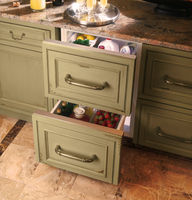Jason Landau, owner of Amazing Spaces, LLC kitchen design firm was quoted in a recent syndicated news article "Good kitchen design is all about interior flow”.
Landau, with his architectural background and years of experience in designing some of the most beautiful kitchens in the Northeast, knows that how a kitchen looks isn't the only important thing...how it functions is the vital element.
A good layout for a kitchen allows for dedicated areas for meal preparation, cleanup, storage and perhaps even entertaining.
Landau always starts with the basics.
The classic triangle (the distance between the sink, refrigerator and cooktop) means that each of these areas become a focal point and each forms three points of a triangle with different distance between them. Saving steps for the cook, the properly planned kitchen triangle provides the most efficient food prep area and creates an easy-to-reach cleanup area.
In classic kitchen design, the total distance from the sink to the stove to the refrigerator and back to the sink should be not less than 12 feet total nor more than 27 feet. Each triangle leg should measure between 4 and 9 feet in length. The kitchen aisle should be at least 42 to 48 inches wide to allow people to move around easily and for appliances to be opened with ease.
A good layout places the appliances properly to ensure the best workable area. The sink needs to be close to the dishwasher for easy loading. The refrigerator should be at hand near food prep areas. Food disposal and recycling bins should be near cleanup areas. Cooking utensils, pots and pans should be stored nearby the stove and every kitchen needs plenty of drawers.
An experienced designer like Landau meets with his clients when he plans to renovate or build a new kitchen for them, and has in-depth conversations with them about their needs, striving to fully understand how they actually use a kitchen. Most clients now count on their kitchens to be multi-use.
Kitchen islands are very popular in homes and can help keep work areas traffic-free, while providing extra food prep, counter and storage space. The island can even host an extra sink, a mini-fridge, an island grill or even a wine rack.
Kitchen alcoves hosting a table (once nearly extinct as formal dining rooms became the must-haves) have made resurgence for casual meals, and as a place to do homework, as a child’s play space or even do double-duty as a desk.
Kitchens opening to a family room with entrainment cabinetry, bookcases, comfortable furniture and the de rigueur widescreen TV are always a favorite and allow the chef to join the conversations while preparing a meal.
But there are classic shapes to kitchen design and each has its benefits depending on how you plan to use the kitchen:
L-shaped: This shape can be used in both large and smaller kitchens and often allows for a center island. With two or three appliances on one wall, a refrigerator at one end, the sink in the middle and the cooktop on the other, this shape allows good traffic flow
Double L-shaped: With room for plenty of counter and cabinet space, this shape can even be designed to accommodate two people cooking, allowing each their separate area.
U-shaped: This shape has three walls with the sink usually in the middle wall section and the cooktop and refrigerator on the side walls across from each other. This makes for an efficient working triangle. You might need to make use of Lazy Susan’s or pullout shelves to accommodate the corner cabinets this design requires and use large windows, skylights or task lighting to lighten up the darkness sometimes caused by the many cabinets used in this design.
G-Shaped: This layout gives you a fourth wall to use for a counter or island. You'll have room for two cooktops or two sinks and conceivably two work triangles—say one for the sink, cooktop and refrigerator and the other for another cooktop, sink and maybe a grill. This affords plenty of room to two cooks to work in tandem.
Galley: If space is limited, the galley-shaped design saves the day. The cooktop should be on one wall and the sink and refrigerator on the opposite walls, so as not to impede the flow. If both ends of the galley are open, the refrigerator should be placed at one end so family members can grab a soda without disturbing the cook. (This is definitely a kitchen designed for one cook.) Using tall (to the ceiling cabinets) helps maximize storage
Single-Wall:
For that apartment in the city, the design placing all appliances and cabinets on one wall helps make the most of a smaller space. In this design, the sink is between the refrigerator and stove, with the refrigerator door opening away from the kitchen sink.
An experienced kitchen designer, like Jason Landau of Amazing Spaces, LLC can make sure that the flow in your new kitchen keeps traffic moving and saves the cook many steps. Amazing Spaces, LLC can turn your nightmare kitchen into a dream. Call today to start the conversation. 914-239-3725 or visit us at http://www.amazingspacesllc.com.









